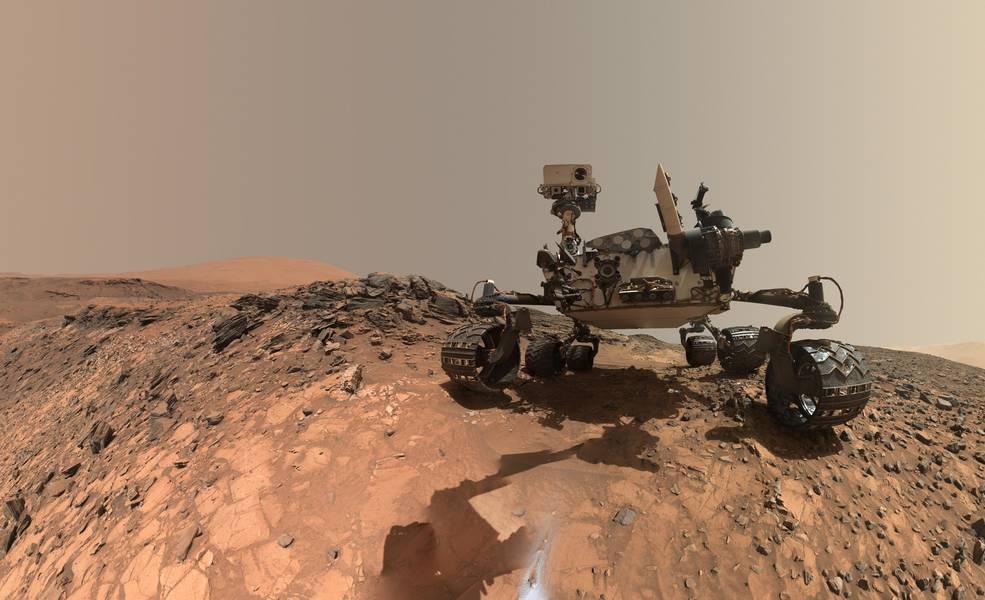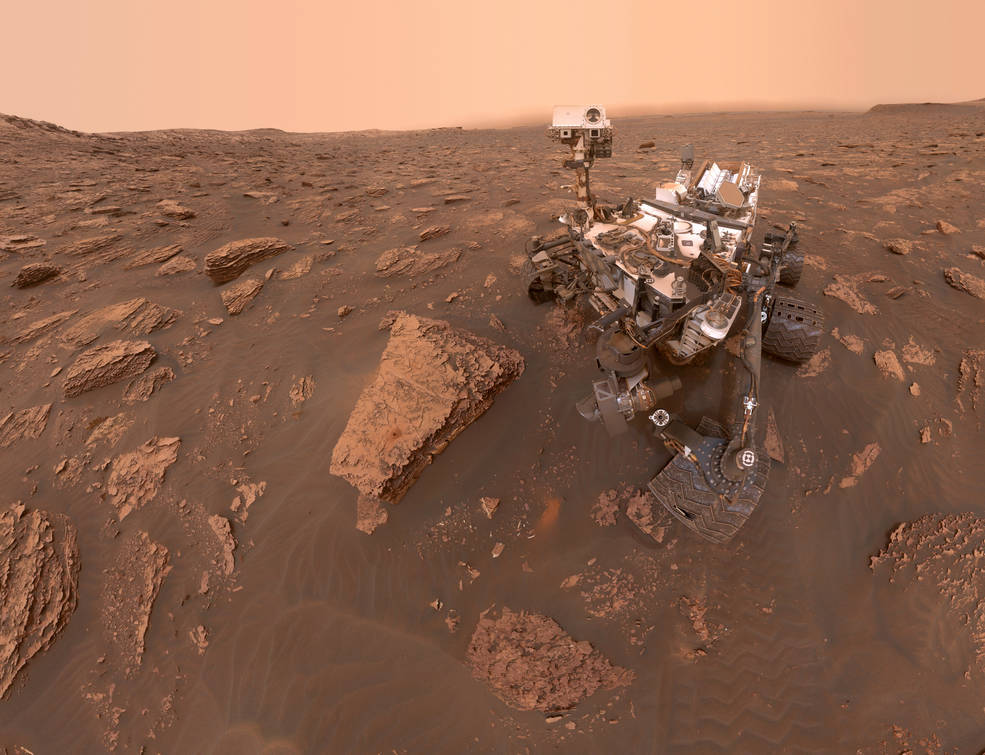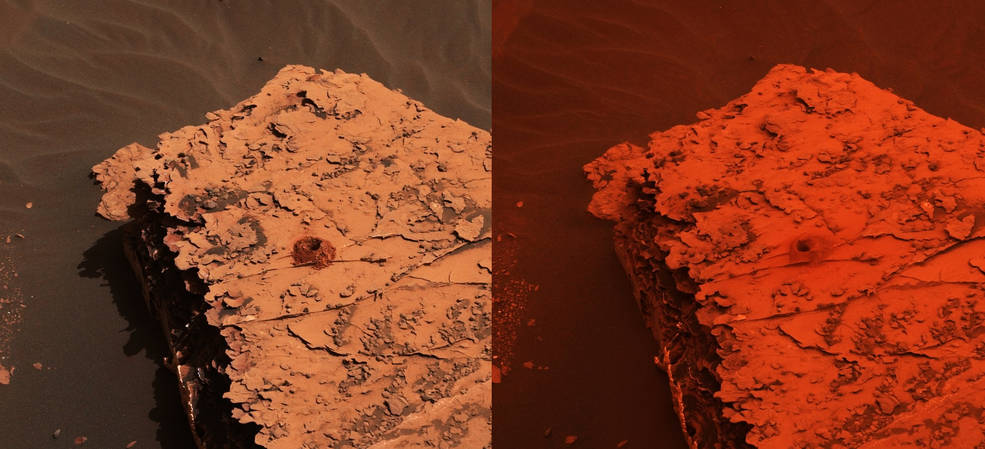June 24 - 30, 2018: Issue 365
Martian Dust Storm Grows Global:
Curiosity Captures Thickening Haze

Martian Dust Storm Grows Global: Curiosity Captures Photos Of Thickening Haze
June 22, 2018
A storm of tiny dust particles has engulfed much of Mars over the last two weeks and prompted NASA’s Opportunity rover to suspend science operations. But across the planet, NASA’s Curiosity rover, which has been studying Martian soil at Gale Crater, is expected to remain largely unaffected by the dust. While Opportunity is powered by sunlight, which is blotted out by dust at its current location, Curiosity has a nuclear-powered battery that runs day and night.
The Martian dust storm has grown in size and is now officially a "planet-encircling" (or "global") dust event, according to Bruce Cantor, deputy principal investigator of the Mars Color Imager camera onboard NASA's Mars Reconnaissance Orbiter. Malin Space Science Systems, San Diego, provided and operates MARCI.

A self-portrait by NASA's Curiosity rover taken on Sol 2082 (June 15, 2018). A Martian dust storm has reduced sunlight and visibility at the rover's location in Gale Crater. A drill hole can be seen in the rock to the left of the rover at a target site called "Duluth." Credits: NASA/JPL-Caltech/MSSS
Though Curiosity is on the other side of Mars from Opportunity, dust has steadily increased over it, more than doubling over the weekend. The atmospheric haze blocking sunlight, called "tau," is now above 8.0 at Gale Crater — the highest tau the mission has ever recorded. Tau was last measured near 11 over Opportunity, thick enough that accurate measurements are no longer possible for Mars' oldest active rover.
For NASA's human scientists watching from the ground, Curiosity offers an unprecedented window to answer some questions. One of the biggest: Why do some Martian dust storms last for months and grow massive, while others stay small and last only a week?
“We don’t have any good idea,” said Scott D. Guzewich, an atmospheric scientist at NASA's Goddard Space Flight Center in Greenbelt, Maryland, leading Curiosity's dust storm investigation.
Curiosity, he points out, plus a fleet of spacecraft in the orbit of Mars, will allow scientists for the first time to collect a wealth of dust information both from the surface and from space. The last storm of global magnitude that enveloped Mars was in 2007, five years before Curiosity landed there.

In June 2018 NASA's Curiosity Rover used its Mast Camera, or Mastcam, to snap photos of the intensifying haziness the surface of Mars, caused by a massive dust storm. The rover is standing inside Gale Crater looking out to the crater rim. The photos span about a couple of weeks, starting with a shot of the area before the storm appeared. Credits: NASA
In the animation above, Curiosity is facing the crater rim, about 18.6 miles (30 kilometers) away from where it stands inside the crater. Daily photos captured by its Mast Camera, or Mastcam, show the sky getting hazier. This sun-obstructing wall of haze is about six to eight times thicker than normal for this time of season.
Curiosity's engineers at NASA's Jet Propulsion Laboratory in Pasadena, California, have studied the potential for the growing dust storm to affect the rover's instruments, and say it poses little risk. The largest impact is to the rover's cameras, which require extra exposure time due to the low lighting. The rover already routinely points its Mastcam down at the ground after each use to reduce the amount of dust blowing at its optics. JPL leads the Mars Science Laboratory/Curiosity mission.

Two images from the Mast Camera (Mastcam) on NASA's Curiosity rover depicting the change in the color of light illuminating the Martian surface since a dust storm engulfed Gale Crater. The left image shows the "Duluth" drill site on Sol 2058 (May 21); the right image is from Sol 2084 (June 17). The cherry red color is due to red dust grains in the atmosphere letting red light through to the surface, but not green or blue, and to different exposure times for the two images. Credits: NASA/JPL-Caltech/MSSS
Martian dust storms are common, especially during southern hemisphere spring and summer, when the planet is closest to the Sun. As the atmosphere warms, winds generated by larger contrasts in surface temperature at different locations mobilize dust particles the size of individual talcum powder grains. Carbon dioxide frozen on the winter polar cap evaporates, thickening the atmosphere and increasing the surface pressure. This enhances the process by helping suspend the dust particles in the air. In some cases, the dust clouds reach up to 40 miles (60 kilometers) or more in elevation.
Though they are common, Martian dust storms typically stay contained to a local area. By contrast, the current storm, if it were happening on Earth, would cover the area of North America and Russia combined, said Guzewich.
The dust storm may seem exotic to some Earthlings, but it’s not unique to Mars. Earth has dust storms, too, in desert regions such as North Africa, the Middle East and the southwest United States.
But conditions here prevent them from spreading globally, said Ralph A. Kahn, a Goddard senior research scientist who studies the atmospheres of Earth and Mars. These include the structure of our thicker atmosphere and stronger gravity that helps settle dust. Earth also has vegetation cover on land that binds the soil with its roots and helps block the wind and rain that wash the particles out of the atmosphere.
By Lonnie Shekhtman
NASA's Goddard Space Flight Center, Greenbelt, Md.
NASA Finds Ancient Organic Material, Mysterious Methane On Mars
June 8, 2018
NASA’s Curiosity rover has found new evidence preserved in rocks on Mars that suggests the planet could have supported ancient life, as well as new evidence in the Martian atmosphere that relates to the search for current life on the Red Planet. While not necessarily evidence of life itself, these findings are a good sign for future missions exploring the planet’s surface and subsurface.
The new findings – “tough” organic molecules in three-billion-year-old sedimentary rocks near the surface, as well as seasonal variations in the levels of methane in the atmosphere – appear in the June 8 edition of the journal Science.
Organic molecules contain carbon and hydrogen, and also may include oxygen, nitrogen and other elements. While commonly associated with life, organic molecules also can be created by non-biological processes and are not necessarily indicators of life.
“With these new findings, Mars is telling us to stay the course and keep searching for evidence of life,” said Thomas Zurbuchen, associate administrator for the Science Mission Directorate at NASA Headquarters, in Washington. “I’m confident that our ongoing and planned missions will unlock even more breathtaking discoveries on the Red Planet.”
“Curiosity has not determined the source of the organic molecules,” said Jen Eigenbrode of NASA’s Goddard Space Flight Center in Greenbelt, Maryland, who is lead author of one of the two new Science papers. “Whether it holds a record of ancient life, was food for life, or has existed in the absence of life, organic matter in Martian materials holds chemical clues to planetary conditions and processes.”
Although the surface of Mars is inhospitable today, there is clear evidence that in the distant past, the Martian climate allowed liquid water – an essential ingredient for life as we know it – to pool at the surface. Data from Curiosity reveal that billions of years ago, a water lake inside Gale Crater held all the ingredients necessary for life, including chemical building blocks and energy sources.
“The Martian surface is exposed to radiation from space. Both radiation and harsh chemicals break down organic matter,” said Eigenbrode. “Finding ancient organic molecules in the top five centimeters of rock that was deposited when Mars may have been habitable, bodes well for us to learn the story of organic molecules on Mars with future missions that will drill deeper.”
Seasonal Methane Releases
In the second paper, scientists describe the discovery of seasonal variations in methane in the Martian atmosphere over the course of nearly three Mars years, which is almost six Earth years. This variation was detected by Curiosity’s Sample Analysis at Mars (SAM) instrument suite.
Water-rock chemistry might have generated the methane, but scientists cannot rule out the possibility of biological origins. Methane previously had been detected in Mars' atmosphere in large, unpredictable plumes. This new result shows that low levels of methane within Gale Crater repeatedly peak in warm, summer months and drop in the winter every year.
"This is the first time we've seen something repeatable in the methane story, so it offers us a handle in understanding it," said Chris Webster of NASA’s Jet Propulsion Laboratory (JPL) in Pasadena, California, lead author of the second paper. "This is all possible because of Curiosity's longevity. The long duration has allowed us to see the patterns in this seasonal 'breathing.'"
Finding Organic Molecules
To identify organic material in the Martian soil, Curiosity drilled into sedimentary rocks known as mudstone from four areas in Gale Crater. This mudstone gradually formed billions of years ago from silt that accumulated at the bottom of the ancient lake. The rock samples were analyzed by SAM, which uses an oven to heat the samples (in excess of 900 degrees Fahrenheit, or 500 degrees Celsius) to release organic molecules from the powdered rock.
SAM measured small organic molecules that came off the mudstone sample – fragments of larger organic molecules that don’t vaporize easily. Some of these fragments contain sulfur, which could have helped preserve them in the same way sulfur is used to make car tires more durable, according to Eigenbrode.
The results also indicate organic carbon concentrations on the order of 10 parts per million or more. This is close to the amount observed in Martian meteorites and about 100 times greater than prior detections of organic carbon on Mars’ surface. Some of the molecules identified include thiophenes, benzene, toluene, and small carbon chains, such as propane or butene.
In 2013, SAM detected some organic molecules containing chlorine in rocks at the deepest point in the crater. This new discovery builds on the inventory of molecules detected in the ancient lake sediments on Mars and helps explains why they were preserved.
Finding methane in the atmosphere and ancient carbon preserved on the surface gives scientists confidence that NASA's Mars 2020 rover and ESA’s (European Space Agency's) ExoMars rover will find even more organics, both on the surface and in the shallow subsurface.
These results also inform scientists’ decisions as they work to find answers to questions concerning the possibility of life on Mars.
“Are there signs of life on Mars?” said Michael Meyer, lead scientist for NASA's Mars Exploration Program, at NASA Headquarters. “We don’t know, but these results tell us we are on the right track.”
This work was funded by NASA's Mars Exploration Program for the agency’s Science Mission Directorate (SMD) in Washington. Goddard provided the SAM instrument. JPL built the rover and manages the project for SMD.
Information on NASA’s Mars activities is available online at: https://www.nasa.gov/mars
Curiosity’s New Mars Science Results On This Week @NASA
June 8, 2018: A new crew aboard the space station, Curiosity rover’s new science findings on Mars, and – Celebrating 60 years of NASA - plans to send humans back to the moon and on to Mars … a few of the stories to tell you about – This Week at NASA!